AI Entrepreneurship: The Ultimate Guide To Get Started [2023]
Today, I’ll show you everything I learned by trial and error with AI entrepreneurship. And no, you don’t need to learn how to code.
Tech titans like Chimav Palihappatiya have already confirmed that artificial intelligence is the next hype cycle within Silicon Valley in the startup world. If you are looking to take part in this once-in-a-lifetime opportunity to start an AI business, then you are in exactly the right place.
I figured all these steps out the hard way so you don’t have to. We’ll also go over the 3 easiest AI business models that people are exploiting right now that you can take and copy and paste into different industries.
- , AI
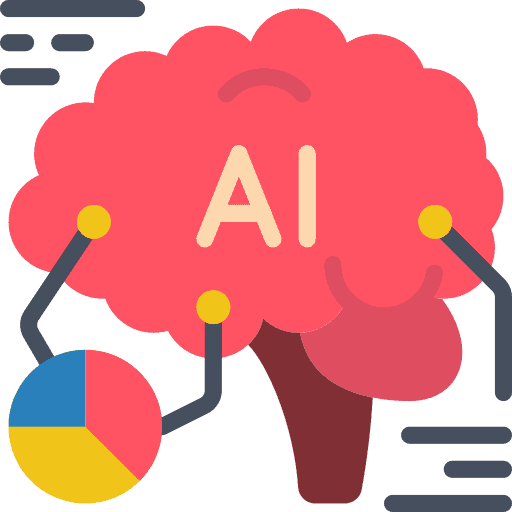
What is Artificial intelligence?
Artificial intelligence or AI refers to the simulation of human intelligence within machines that are designed to think and act like humans. Essentially, AI attempts to perform tasks that would normally require human intelligence.
By this definition, AI has already replaced humans in data entry, medical diagnosis, fraud detection, and customer service.
Benefits of AI for Entrepreneurs
There are multiple benefits to AI for business, such as:
- Lower cost
- Infinite scalability
- No human error, and
- Data back decision making
The benefits of creating artificial intelligence systems to replace humans in tasks like these are that once created and trained, artificial intelligence does not need to take a break. It doesn’t complain. It doesn’t need days off.
Understanding the Different Domains of AI: Machine Learning, Natural Language Processing, and Robotics
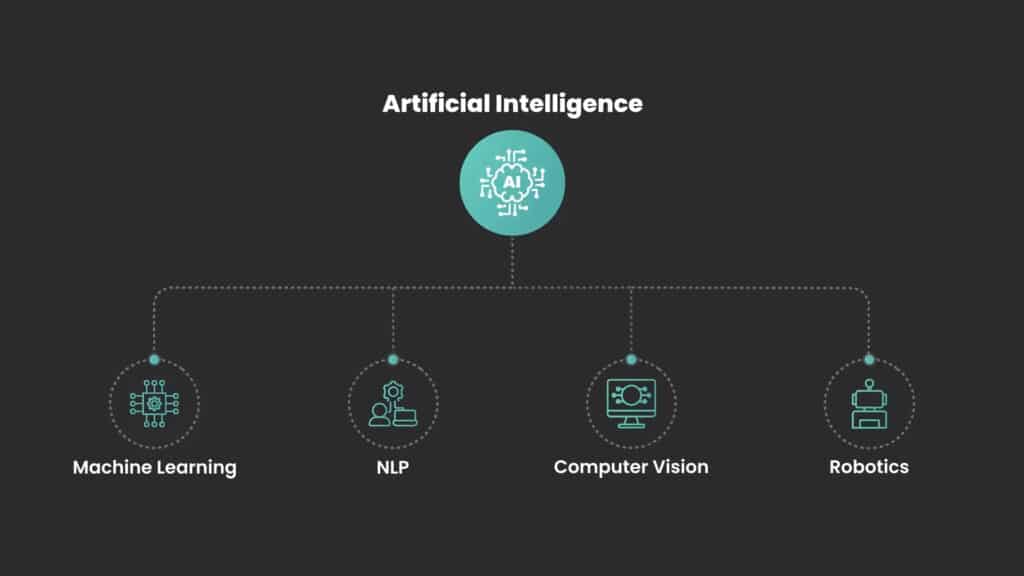
The term AI itself can actually be quite confusing as there are a number of different aspects that get thrown in the mix at the same time.
Turns out AI is actually an umbrella term that many of the other categories that you may be familiar with fall under:
- Machine Learning
- Natural Language Processing (NLP)
- Computer Vision
- Robotics
And many others.
How Machine Learning Works: Examples of Predictive Models
Machine learning or ML is a core aspect of artificial intelligence, and it’s the process of giving a computer a ton of information so that it can learn off that information and then start to predict outcomes so that we don’t have to tell it what to do every single time.
For example, a machine learning model could be used to predict the price of a house based on its size, area, and room. Or a machine learning model could be used to classify emails as spam or not spam.
What you need to do is provide it with a ton of labeled examples of what is spam and what isn’t spam.
Natural Language Processing: The Key to Human-Computer Interaction
Natural language processing is another core aspect of the AI tools that we’re familiar with today, which helps computers to understand, interpret, and generate human language like when you’re talking to Siri or Alexa.
Early on, I had a bit of trouble understanding the distinction between these terms, but the easiest way to understand it is that AI is the umbrella term, and these different disciplines are combined together to make these products like Chat GPT or Siri, or robotics and warehouses as well.
They come together to form the final product, which is intelligence.
Large Language Models: The Hottest Topic in AI
Due to the record-breaking public reception of Chat GPT which got more than 1mln users in just one week, the hottest topic in AI right now is large language models.
Large language models or LLMs are advanced AI algorithms that generate human-like text.
They are trained on enormous amounts of data and work by breaking down the text into components, learning patterns, and then using that knowledge to generate new text.
And of course, the larger the training data set, the more accurate the model becomes. GPT-3 by Open AI is the language model that Chat GPT was built on top of and is arguably the best publicly available large language model we have today.
It was trained on hundreds of billions of words, and its success at GPT-4 will likely be many times that. The easiest way to think about these models is to imagine them as extremely powerful autocomplete engines.
Given just a few words, these large language models can write an entire short story or paragraph by pulling on similar collections of words within their training data.
Furthermore, they are excellent at pattern recognition and pattern generation, allowing us to carefully craft the kinds of output that we want out of them.
The Opportunity for AI Entrepreneurs: Building Applications on Top of Large Language Models
The biggest opportunity for us as AI entrepreneurs right now is to be building applications on top of these hugely powerful models. Companies like Google and OpenAI are doing all of the hard work of building these massive language models.
All we need to do is go and apply them to specific use cases. In order to build these applications and build on top of these models, we need access to them programmatically, which brings us to our next step – understanding APIs.
Understanding APIs: What They Are & How They Work
APIs or application programming interfaces are how entrepreneurs like us can get access to the power of these models and start building value on top of them.
APIs can be a little bit complicated, so here’s an analogy to breaking it down for you.
Just like you order food off a menu at a restaurant, a programmer can access specific functionality from a software application through the API.

In our case, we have APIs that allow us access to services by companies like Open AI and soon to be Google and others.
For example, the options on Open AI’s menu are the different submodels that they’ve trained that are good for different purposes.
The options on this menu range from Da Vinci to Aida, with Da Vinci being the most advanced language model that powers things like Chat GPT, down to Aida, which is only capable of doing very basic functionality.
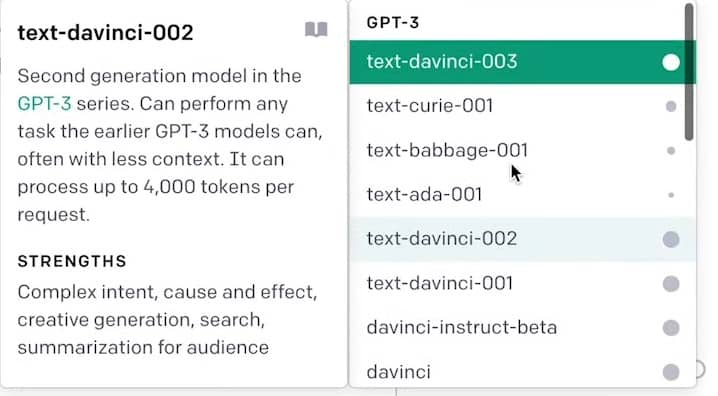
They also have some models that are specialized towards code rather than language, so they offer a whole bunch of different options for you to access programmatically and build your applications on top of.
We can interact with these models and leverage their power by making what’s called an API call to them. Within these calls, you need to provide a bit of information to specify what you want back.
For example, let’s say we are creating a resume creation tool. We would need to collect user input containing their personal information such as email, phone number, and work history through a site or a form.
Then combine that information with some simple instructions explaining to the API what we want to do, and then we bundle that all together and send it off in a call.
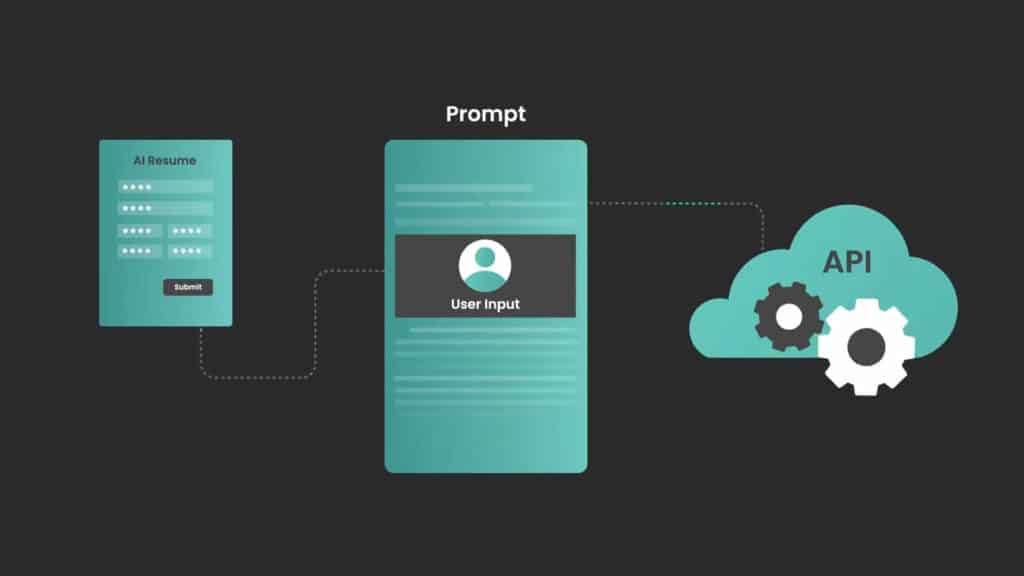
The API would then process our request and send back the response. Because this is all done programmatically, once you have a reliable way of collecting user input and you have those instructions that you send off to the API written perfectly, then you are able to take this, repeat it over and over again, and scale it into a business.
However, the writing of these instructions is an entirely separate skill in itself.
Understanding Prompt Engineering
This skill is actually so important that I’ve already written an entire prompt engineering guide. But for now, I’ll give you a brief summary. The correct term for instructing an artificial intelligence to do a task is known as prompting.

Basically, we tell the AI, for example, Open AI’s GPT 3, a set of instructions, and it performs a task based on those instructions.
Prompts can be as simple as a phrase or a question or as complex as multiple paragraphs.
The reason prompt engineering or simply how you create your prompts is so important is because of a concept called “garbage in, garbage out“.
Essentially, the quality of your input determines the quality of your output. When you have large language models as powerful as GPT-3 and others, your ability to write good prompts determines the value that you can extract from them.
Entire businesses are being built on the back of a few well-written prompts or even just one.
Finally, what you’ve all been waiting for is the easiest way you can build on top of these large language models.
Building an AI Business on LLMs
Now that you’ve been brought up to speed on all the different aspects of AI entrepreneurship, you need to start piecing it all together.
Of course, the big question is how can you use all of this knowledge to not only identify but execute on your next big idea.
Here are the three best AI business formats that you can start copying and pasting into different industries today, and I’m saving the best one for last.
And if you’d like some specific AI entrepreneurship ideas, I’ve also put together a list of best ChatGPT business ideas.
1. Prompt Based Businesses
Business format number one is prompt-based businesses. This business format requires you to find a specific use case and then write one or many really well-crafted prompts that convert these large language models into tools for that specific use case.
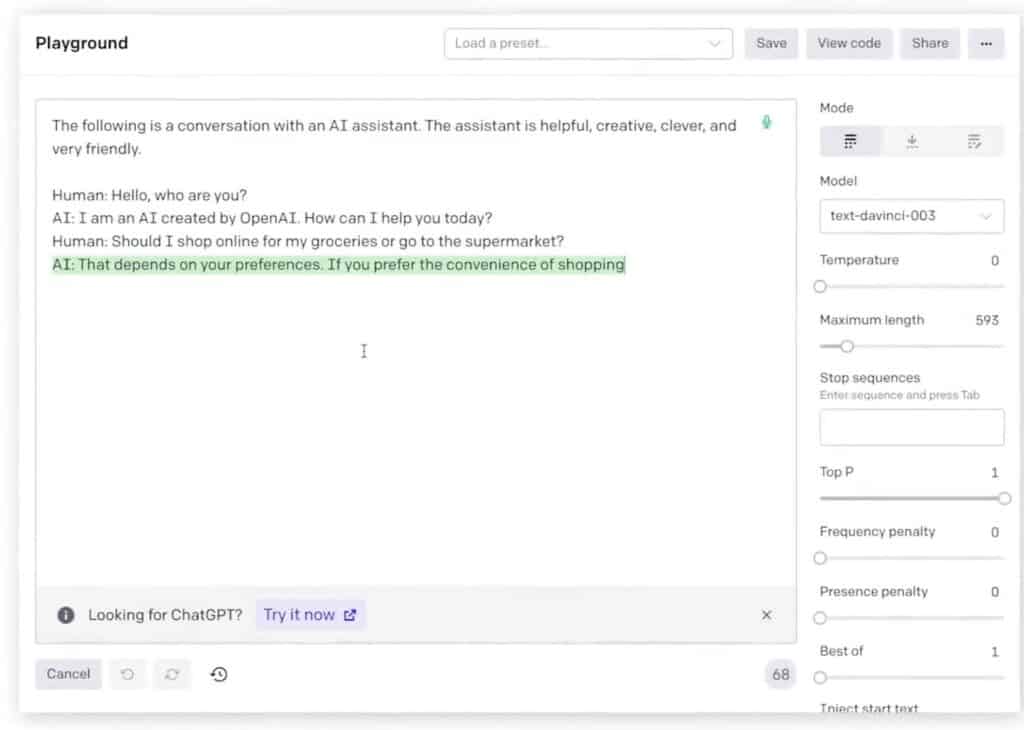
Once you’ve played around and constructed these prompts, then all you need to do is host this on a website and start marketing it.
The simplest way to do this is to write a good prompt, take in some user input from your website, mash them together, and send it off in the API call.
What comes back can be a really customized response for people and it looks like magic to them.
But under the hood, it’s very low effort and very basic to get one of these up and running because you’re essentially just taking a large language model like GPT-3, giving it some instructions, shoving in some user input, and then letting it run the response back.
For example, you could use an AI-powered resume writing tool and then craft the prompt that shows GPT-3 the format, the best possible format for a resume, and then include that in the prompt and then include the user information, send it off in an API call and get it back and give that to the user.
Or you could create some interesting copywriting tools like copy.ai have done.
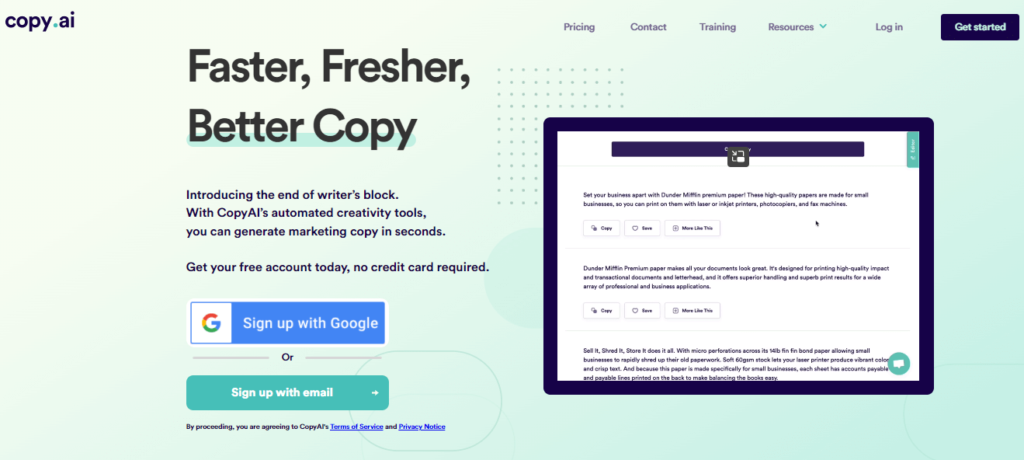
For example, you could create a Facebook ad UGC copy creator, which takes in some information on the company, and the products, and will always spread out a nice Facebook ad copy that includes quotations and product reviews in it.

Something like AdCreative.ai has done.
Out of the 3, this AI business model has the lowest barrier of entry as essentially all you need to do is write a good prompt.
Playing around with building these basic prompt-based tools is the perfect way to get your feet wet with AI entrepreneurship. I strongly urge you guys to get into the open AI playground and start having a play around and writing some prompts and seeing what you can get out of these models.
2. Fine Tune-Based Business
The next AI business model is a fine-tune-based business. Large language models like GPT 3 can be fine-tuned.
Essentially, fine-tuning allows you to teach a model to recognize new patterns. Chat GPT is an excellent example of this because Open AI has fine-tuned GPT-3 language model, in order to operate in a Q&A style by training it and giving it some examples of question-and-answer style prompts.
Fine-tuning can be used to create tools that improve a large language model for a specific purpose.
For example, you could fine-tune one of these models to become an expert social media sentiment analysis bot.
What you need to do is get a ton of Twitter comments, Instagram comments, and Facebook comments, label them as positive or negative, and then you can pipe that into the model to fine-tune it.
The resulting fine-tune model would be better at predicting the positive or negative sentiment of social media comments than the underlying GPT model itself.
While GPT-3 can already do sentiment analysis on its own, by providing it with these examples, you’re making it more niche down to being better at dealing with social media comments in particular.
The most difficult part about this business format is that you need appropriate data to fine-tune with.
This is where some light bulbs may be going off for you guys because if you own a business or you know someone who does, who has a ton of valuable and interesting data that could be used to fine-tune these models for a different purpose.
Then you have an excellent opportunity to use that data, fine-tune it, and create new software as a service.
As with most things in artificial intelligence and AI, the more data you can provide it with, the better the model will perform.
3. Custom Data Chatbot Business
Finally, the business format that I think has the most potential is a custom data chatbot business.
Now, don’t switch off because you’ve heard the word chatbot, hear me out.
If you can get your hands on some valuable data, be it through your own business or a friend, or you reach out to someone and offer to partner with them and create this chatbot service, if you can be the first people in your niche to provide some chatbot service, then you have a really good chance of making some serious money.
The main opportunity that I see for these chatbots is making complex database-structured data available in simple and easy-to-access ways to consumers.
The issue of getting data into these models so that they can be used for different use cases was something that puzzled me for a long time.
Recently, I connected the dots that you can use these models to convert natural language like a sentence into a database query. This essentially allows you to convert any database you have with some interesting data in it into a chatbot service.
One example of this in action could be an e-commerce reporting assistant for brand owners.
This assistant could take in a natural language prompt like, what were the 3 best-performing products for the month of December based on conversion rate.
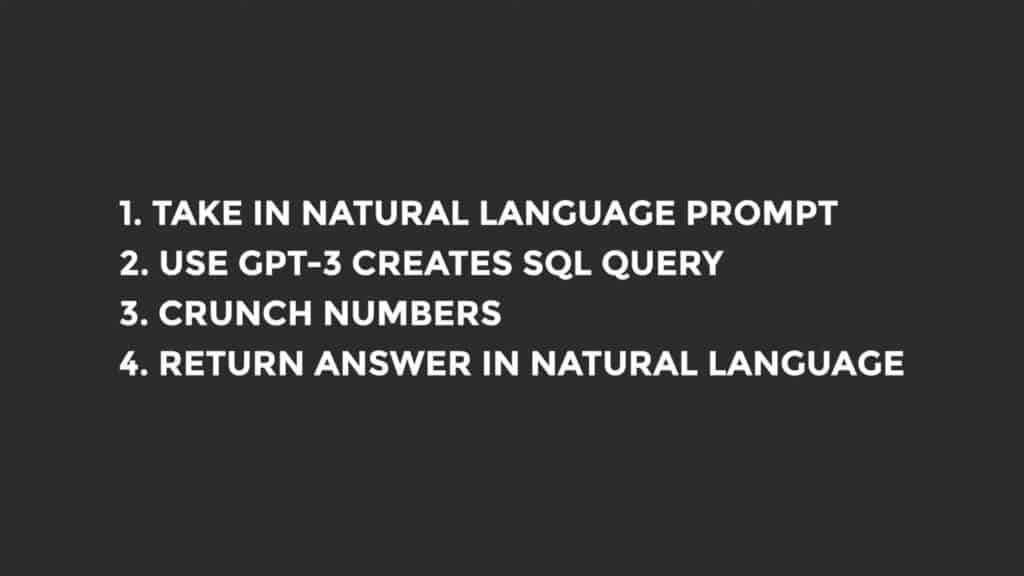
You can send that information off to an API endpoint and receive it back in a database query that you can use to look up your database, pull that data, format it into a nice sentence, and then give it back to the user.
AI Entrepreneurship Final Words
So this is all I’ve got for this guide on AI for entrepreneurs. You are now equipped with enough information to get out there and start sniffing out those life-changing AI business opportunities that are going to be popping up everywhere.
The best part is that you’re still so early. You not only have a knowledge advantage, but you also have a time advantage.
The rest of the world is only just waking up to the huge opportunities in AI right in front of us, so you need to play your advantage to the fullest.
Patryk Miszczak

